How To You Awk To Filter By Row
When nosotros run sure commands in Unix/Linux to read or edit text from a string or file, we most times try to filter output to a given section of interest. This is where using regular expressions comes in handy.
Read Also: 10 Useful Linux Chaining Operators with Practical Examples
What are Regular Expressions?
A regular expression can be defined as a strings that stand for several sequence of characters. One of the virtually important things near regular expressions is that they allow you to filter the output of a command or file, edit a department of a text or configuration file and then on.
Features of Regular Expression
Regular expressions are fabricated of:
- Ordinary characters such as space, underscore(_), A-Z, a-z, 0-nine.
- Meta characters that are expanded to ordinary characters, they include:
-
(.)it matches whatsoever single character except a newline. -
(*)it matches nix or more existences of the immediate grapheme preceding it. -
[ character(due south) ]it matches any i of the characters specified in character(s), one tin can also apply a hyphen(-)to mean a range of characters such equally[a-f],[1-5], and then on. -
^it matches the beginning of a line in a file. -
$matches the end of line in a file. -
\it is an escape graphic symbol.
-
In guild to filter text, ane has to utilize a text filtering tool such equally awk. You tin think of awk as a programming language of its own. But for the scope of this guide to using awk, we shall cover it as a simple control line filtering tool.
The general syntax of awk is:
# awk 'script' filename
Where 'script' is a fix of commands that are understood by awk and are execute on file, filename.
Information technology works by reading a given line in the file, makes a re-create of the line and so executes the script on the line. This is repeated on all the lines in the file.
The 'script' is in the form '/blueprint/ action' where blueprint is a regular expression and the action is what awk volition do when it finds the given blueprint in a line.
How to Utilize Awk Filtering Tool in Linux
In the following examples, we shall focus on the meta characters that we discussed above under the features of awk.
A uncomplicated example of using awk:
The example below prints all the lines in the file /etc/hosts since no blueprint is given.
# awk '//{print}'/etc/hosts 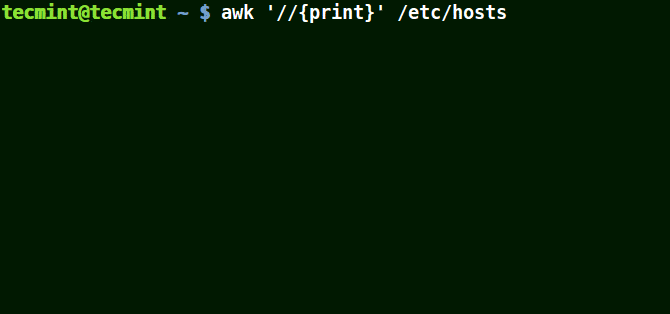
Use Awk with Pattern:
I the instance below, a pattern localhost has been given, and so awk will lucifer line having localhost in the /etc/hosts file.
# awk '/localhost/{impress}' /etc/hosts 
Using Awk with (.) wild bill of fare in a Pattern
The (.) will match strings containing loc, localhost, localnet in the example beneath.
That is to say * l some_single_character c *.
# awk '/l.c/{impress}' /etc/hosts 
Using Awk with (*) Character in a Pattern
It volition friction match strings containing localhost, localnet, lines, capable, as in the example below:
# awk '/l*c/{print}' /etc/localhost 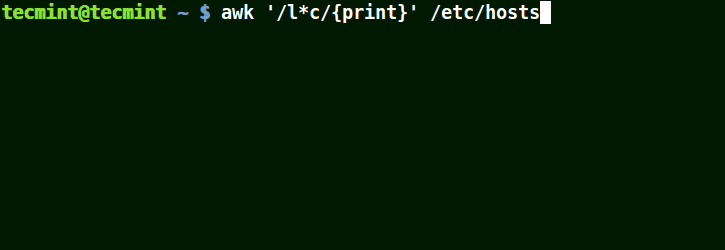
Y'all will likewise realize that (*) tries to a get y'all the longest match possible it can detect.
Let expect at a instance that demonstrates this, take the regular expression t*t which means match strings that showtime with letter of the alphabet t and end with t in the line beneath:
this is tecmint, where you get the all-time expert tutorials, how to's, guides, tecmint.
You will get the following possibilities when you use the pattern /t*t/:
this is t this is tecmint this is tecmint, where you lot get t this is tecmint, where you get the best expert t this is tecmint, where you get the best good tutorials, how t this is tecmint, where y'all get the all-time skillful tutorials, how tos, guides, t this is tecmint, where you get the all-time good tutorials, how tos, guides, tecmint
And (*) in /t*t/ wild menu character allows awk to choose the the last pick:
this is tecmint, where you get the best skillful tutorials, how to'south, guides, tecmint
Using Awk with set [ graphic symbol(s) ]
Take for example the set [al1], here awk will lucifer all strings containing character a or l or i in a line in the file /etc/hosts.
# awk '/[al1]/{print}' /etc/hosts 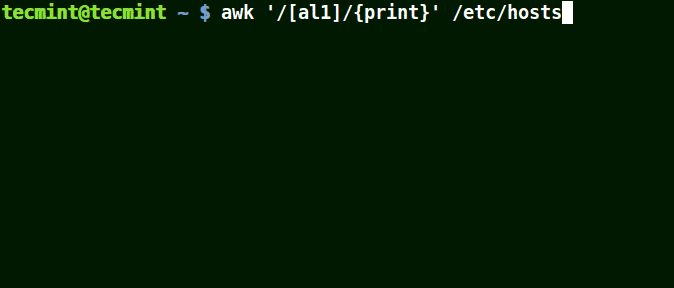
The next instance matches strings starting with either Chiliad or k followed by T:
# awk '/[Kk]T/{print}' /etc/hosts 
Specifying Characters in a Range
Understand characters with awk:
-
[0-nine]means a single number -
[a-z]ways match a single lower example alphabetic character -
[A-Z]means friction match a single upper case letter -
[a-zA-Z]means match a single letter -
[a-zA-Z 0-9]means lucifer a single letter or number
Lets await at an instance below:
# awk '/[0-9]/{impress}' /etc/hosts 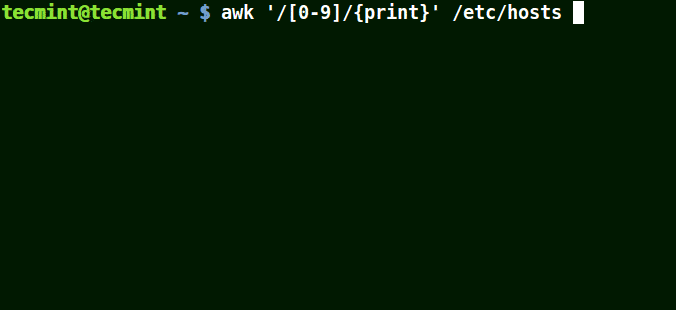
All the line from the file /etc/hosts contain at to the lowest degree a single number [0-9] in the in a higher place example.
Utilise Awk with (^) Meta Character
It matches all the lines that start with the pattern provided equally in the example below:
# awk '/^fe/{impress}' /etc/hosts # awk '/^ff/{print}' /etc/hosts 
Use Awk with ($) Meta Grapheme
It matches all the lines that terminate with the design provided:
# awk '/ab$/{print}' /etc/hosts # awk '/ost$/{print}' /etc/hosts # awk '/rs$/{impress}' /etc/hosts 
Use Awk with (\) Escape Graphic symbol
It allows you to take the graphic symbol following it as a literal that is to say consider it just equally information technology is.
In the case below, the first control prints out all line in the file, the second command prints out nix considering I want to lucifer a line that has $25.00, but no escape character is used.
The third command is correct since a an escape character has been used to read $ as it is.
# awk '//{print}' deals.txt # awk '/$25.00/{print}' deals.txt # awk '/\$25.00/{print}' deals.txt 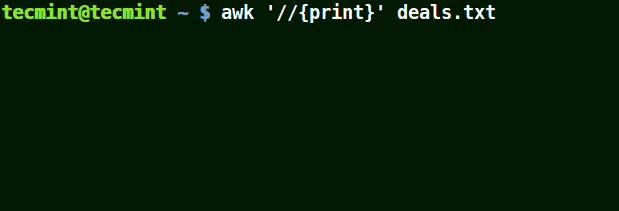
Summary
That is non all with the awk command line filtering tool, the examples to a higher place a the basic operations of awk. In the adjacent parts we shall be advancing on how to apply circuitous features of awk. Cheers for reading through and for any additions or clarifications, mail a comment in the comments section.
If Y'all Appreciate What Nosotros Practice Here On TecMint, You Should Consider:
TecMint is the fastest growing and most trusted community site for any kind of Linux Articles, Guides and Books on the web. Millions of people visit TecMint! to search or scan the thousands of published articles available FREELY to all.
If you like what you are reading, please consider ownership us a coffee ( or 2 ) as a token of appreciation.

Nosotros are thankful for your never ending support.
How To You Awk To Filter By Row,
Source: https://www.tecmint.com/use-linux-awk-command-to-filter-text-string-in-files/
Posted by: raylichannoosee.blogspot.com


0 Response to "How To You Awk To Filter By Row"
Post a Comment